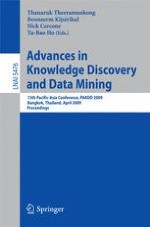This book constitutes the refereed proceedings of the 13th Pacific-Asia Conference on Knowledge Discovery and Data Mining, PAKDD 2009, held in Bangkok, Thailand, in April 2009. The 39 revised full papers and 73 revised short papers presented together with 3 keynote talks were carefully reviewed and selected from 338 submissions. The papers present new ideas, original research results, and practical development experiences from all KDD-related areas including data mining, data warehousing, machine learning, databases, statistics, knowledge acquisition, automatic scientific discovery, data visualization, causal induction, and knowledge-based systems.
